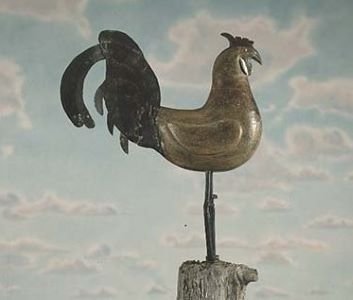West of Eden: Canadian Folk Art
Blitz Magazine
When we think of folk art, we often think of materials produced long, long ago. The term conjures images of Quaker women busy at quilting bees, or aged farmers seeking relief from the stresses of the Great Depression by carving cows from pieces of scrap wood. Well, it turns out that the great age of Canadian folk art was from 1960 to 1990.
Folk art has always been with us. Cave dwellers decorated their walls with depictions of their experiences. The ancient Egyptians, Greeks, Romans and Vikings decorated weather vanes, whirligigs, windmills and banners. Then came decorative clothing, storage trunks and furnishings—all evocative, idealized and miniaturized representations of the images that fill our lives.
Folk art is inspired by the heart and created by untrained people to express their artistic impulses using common, often recycled, materials to create works of enduring beauty. It fulfills a personal need to create something unique, beautiful and, perhaps, useful.
Experts say that outdoor folk art is associated with the human quest to reproduce the Garden of Eden, the perfect habitat for humans, animals and plants, our own places of serenity and fertility. It is produced expressly to stand in, and withstand, the elements. It carries a blend of cultural traditions and regional characteristics, as well as the eccentricities, passions, fantasies and humour of its creators.
It’s interesting to note the consistency in the way folk art is created for its positioning. Pieces intended for front lawns have the essence of street theatre and are meant to catch the attention of passers-by, enhance the property’s appearance, give it its own identity, and differentiate a house from those of its neighbours. Barnyard art combines form and function, e.g. curved doorstops and scarecrows. Pieces made for back yards—the preserve of friends and family, reflect more intimate personal tastes and can range from bird carvings in ponds to erotic statuary.
Outdoor folk art enjoyed an explosion in creative expression beginning in 1960. Lawn statuary, bird houses and wind socks were found, created, decorated and sold, sometimes for enormous prices. But in 1990, the frenzy ceased. Jigsaw statuary and commercial pieces started appearing in places like Costco and Home Depot. Naive art started to disappear—perhaps because no one was naive any more.
In Canada, ethnologist Marius Barbeau (1883-1969) was among the first to recognize that folk art was a worthwhile cultural pursuit. Regional, chronological and ethnic differences in folk art came to be recognized and catalogued, as Barbeau and others began comparative studies of such disparate objects as a 19th century Quebec weathervane and a humorous carving of former Canadian Prime Minister John Diefenbaker. Barbeau’s efforts established This Other Eden: Canadian Folk Art Outdoors, a still-growing collection at the Canadian Museum of Civilization.

